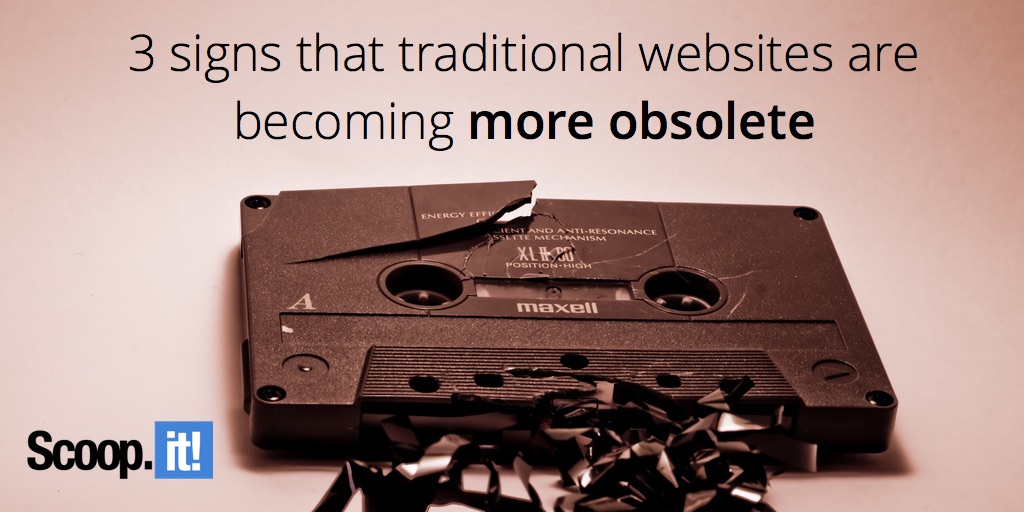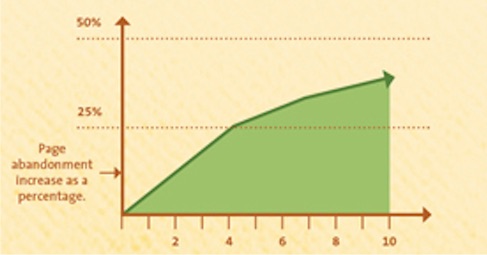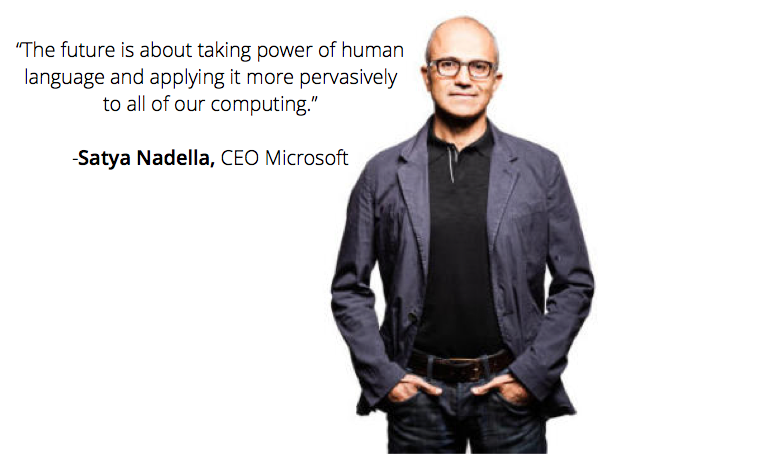
It’s hard to imagine that a thing as universally used as websites could fall by the wayside and join the ranks of retired technology, but consider this historical trend: from the horse-drawn buggy to the evolution of the CD in the music industry, no technology remains in regular use forever.

Image by A.V. Club
Part of the reason we don’t think of websites the same way we do these retired technologies is that people believe digital tech, including websites, can change and evolve to meet demand.
However, this is only true to a certain extent.
40% of consumers will abandon a website if it takes longer than 3 seconds to load, and as these expectations for speed and ease of use continue to climb, websites won’t be able to keep up. As demonstrated in the below chart from Kissmetrics, slower page response time results in an increase in page abandonment:

Image from Kissmetrics: https://blog.kissmetrics.com/loading-time/
Newspapers were replaced by websites because people wanted information faster and with less effort than ever before, and soon websites will be replaced for that very same reason.
Sure, websites have many years left in their lifecycle, but a shift is imminent. Soon, websites will be outdated, and a new structure will reshape the web as we know it. Here are 3 hints that websites are becoming more obsolete in 2016:
1. The death of individuality
When the Web first took off in the ’90s and early 2000s, it was madness. Dubbed the “Wild West Web,” there was no law in web design, and people made whatever kind of websites they wanted to. These websites were “pull-based,” luring site visitors through unique design and bright color palettes, the thinking being that if a site looked and felt different from every other, visitors would remember it and come back.
Of course, such a system ultimately confused users more than it did convince them to buy a product or service online, so as the Web grew, it adapted to its users’ goals instead. Websites became less about creating an unforgettable experience and more about building a pipeline between business and customer, a “push-based” system that focused on fulfilling users’ needs and increasing customer conversion by making things as intuitive for the user as possible. Eventually, this meant people could expect similar experiences across different websites.
The end result is the rise of CMS platforms like WordPress, which alone has built more than a quarter of all websites running today. The purpose of these CMS systems is to quickly and easily get your content out to your audience. In UX Magazine’s article “Why Web Design is Dead,” author Sergio Nouvel describes this shift as moving from “web pages to web services,” a “[transition] to a push-based model of content consumption, where the right information arrives without you even requesting it…[whereas] web pages are static content that need to be found and visited (pull-based).”
To minimize that “pull,” web designers reduce the effort needed to get around the Web by creating nearly identical websites for visitors to navigate. The first sign of a technology’s decline is when it reaches peak performance. We have reached the point where in many ways, websites have been perfected, and the day will come when websites no longer fit the bill for efficient online navigation.
2. The growth of ecosystems
To create this “push-based model of content consumption,” digital ecosystems have evolved to discourage individual websites, instead rewarding would-be website makers to push their content into these ecosystems. What this means is that users accept Google’s answers to a search request rather than click a link, businesses create Facebook Pages rather than their own websites, and people get their news through a news feed like Twitter rather than follow several news sources individually. In an ironic turn, the World Wide Web is becoming smaller, even as the amount of information it contains grows larger.
In the aptly titled 2010 article “The Web Is Dead. Long Live the Internet,” Wired wrote, “One of the most important shifts in the digital world has been the move from the wide-open Web to semiclosed platforms that use the Internet for transport but not the browser for display.” This trend can be seen in the shifts in web traffic. According to the same Wired article, the 10 biggest websites received 31% of US web traffic in 2001, and that figure grew to 75% by 2010.
Users keep visiting the same sites because they answer more and more of their needs as the ecosystem grows.
Jon Lax, director of Product Design at Facebook, believes that “after the dominance of URLs, we’re entering the platform era.. where companies, news outlets and many others are providing their services by building in and on top of outside mobile platforms and operating systems that dictate how they should look.” Expanding into platforms not only means that users will engage with a consistent experience, but individual websites themselves will decline as the majority of traffic continues to funnel through these digital ecosystems instead.
3. The new interface of technology
If one were to trace the decline of websites back to its roots, the beginning of this shift was caused by the explosive popularity of mobile devices. When the first iPhone was released in 2007, no one knew quite how impactful smartphones would become. As of 2015, more searches were made on mobile devices than desktop computers, reinforcing mobile’s rise as the dominant online platform. While responsive web design evolved to adapt websites to the mobile screen, in many ways the move was reactive and not enough for a successful evolution.
As Danny Crichton writes for TechCrunch, “the Web has tried to compete with the ‘mobile web’ concept, but like so many responses to technology disruption, this one seems too little, too late.”
To meet the needs of the mobile user, there needs to be an alternative to manual website navigation, one that doesn’t require fingers fumbling to press small buttons or eyes squinting to read fine type. That solution is on its way. This past March, Microsoft CEO Satya Nadella described the change succinctly:

Image by Qumu
Natural language processing, which combines machine learning with pattern recognition, will allow human conversation to become the new interface of technology through interactions with chatbots and digital assistants.
With such an interface, users will no longer search websites, but have these digital assistants and bots do the searching for them, bringing the information they need right to their screen. With such a drastic change to online search, the traditional idea of a website will no longer be needed. Instead, these bots and assistants (many of which will be bound by local ecosystems) will only need to be able to find the information a website contains, not its visuals or its human-navigable structure. What’s left is simple: data.
Conclusion
In today’s age, it seems like websites are on the decline as platforms and conversational interfaces come to the fore of research and financial investments. Have you noticed any other signs of websites’ decline?
If you want to get 30 effective techniques to master content marketing along with valuable insights from 10+ influencers like Mark Schaefer, Rebecca Lieb, Lee Odden, Jason Miller or Ian Cleary, download our free eBook now!
Image by Andrew Malone.



 (2 votes, average: 4.00 out of 5)
(2 votes, average: 4.00 out of 5)
I think it’s open for debate @thereseroth:disqus. Josh makes great point on the long term trends and we’ve definitely seen Facebook or Medium pickup traction. But the other point to consider is this graph that shows that Facebook is clearly extracting value by forcing businesses to pay to be visible. Do you really want to hand them over the keys to the kingdom? Having your own content hub on your website still matters a lot. As Josh pointed out, it’s getting harder and harder to make it visible but my (biased) opinion on this is that it’s a battle worth… Read more »
No, of course not, I’m a website owner myself☺
And yes, thank you for your realistic, but positive approach……
Cheers,
Therese